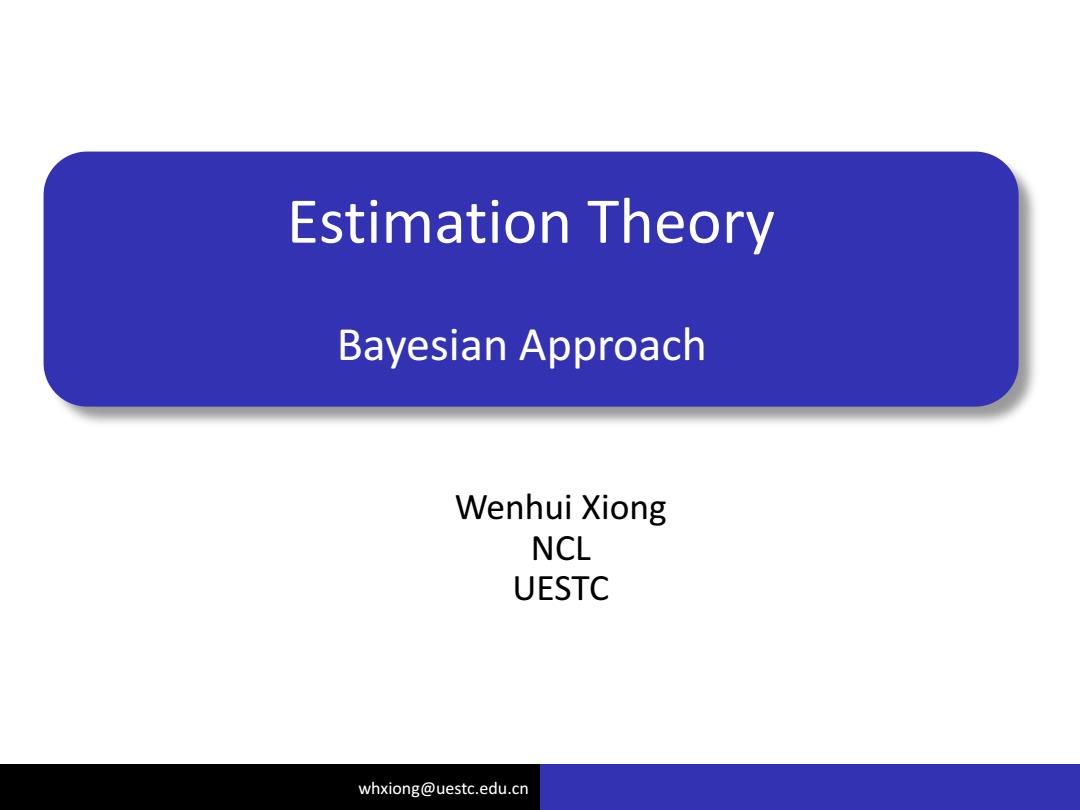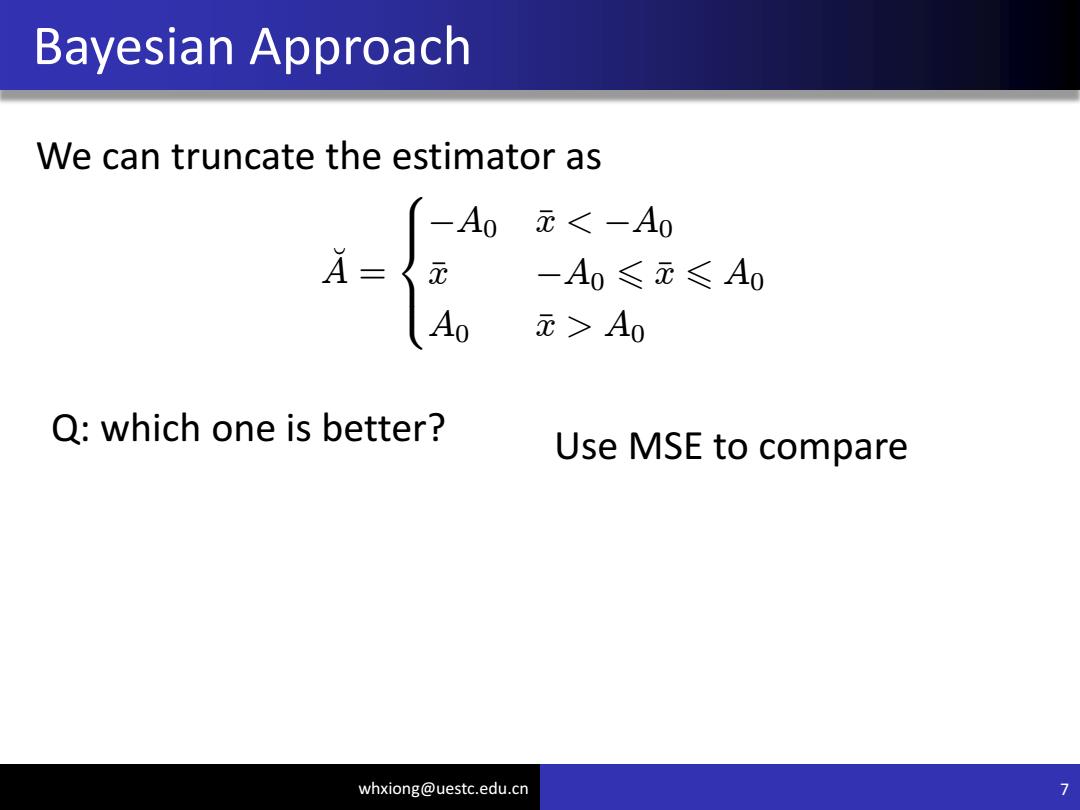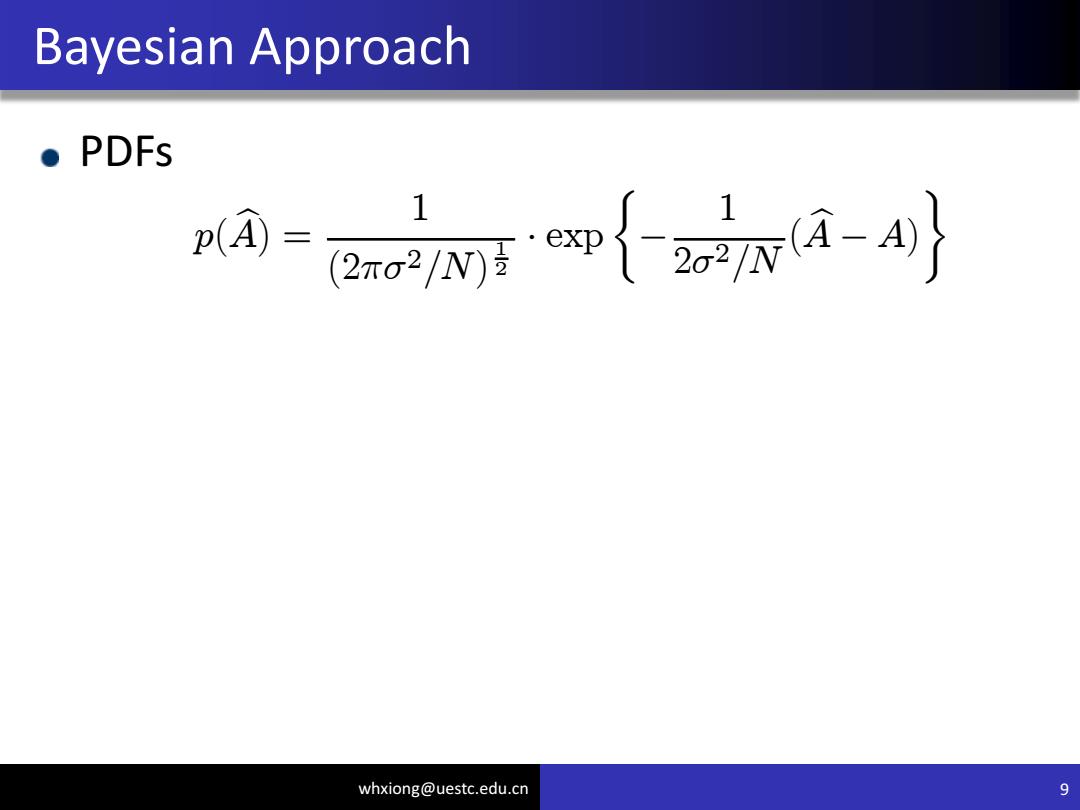
Estimation Theory Bayesian Approach Wenhui Xiong NCL UESTC whxiong@uestc.edu.cn
whxiong@uestc.edu.cn Estimation Theory Bayesian Approach Wenhui Xiong NCL UESTC

Review Estimator CRLB→factorize alnp(x:0) 80 =I(9)(g(x)-8) RBLS: .Use sufficient statistics:T(x)ET(] unbiased estimator over sufficient statistics:g[T(x)] ● BLUE:if the unknown is a linear function of the data ●MLE:known PDF 。Least Square Assumption:unknown is deterministic whxiong@uestc.edu.cn 2
whxiong@uestc.edu.cn Review Estimator 2 CRLB factorize RBLS: Use sufficient statistics: T(x) unbiased estimator over sufficient statistics: g[T(x)] BLUE: if the unknown is a linear function of the data MLE: known PDF Least Square E[µ · jT(x)] Assumption: unknown is deterministic @lnp(x; µ) @µ = I(µ)(g(x) ¡ µ)

Bayesian Approach How about:the unknown is a random variable 0 If the information about the rV is known,the estimator do better? Example:Estimating DC in WGN cn =A+wln whxiong@uestc.edu.cn 3
whxiong@uestc.edu.cn 3 Bayesian Approach How about: the unknown is a random variable If the information about the RV is known, the estimator do better? Example: Estimating DC in WGN x[n] = A + w[n]

Bayesian Approach How about:the unknown is a random variable If the information about the RV is known,the estimator do better? Example:Estimating DC in WGN xIn =A+wln 。MVU:sample mean A=元AW(A,σ2/N) whxiong@uestc.edu.cn 4
whxiong@uestc.edu.cn 4 Bayesian Approach How about: the unknown is a random variable If the information about the RV is known, the estimator do better? Example: Estimating DC in WGN x[n] = A + w[n] MVU: sample mean A b = x¹ A ^ » N(A; ¾ 2 =N)

Bayesian Approach How about:the unknown is a random variable If the information about the RV is known,the estimator do better? Example:Estimating DC in WGN xn =A+wln 。MVU:sample mean A=元A~W(A,o2/N) .What if we add more info.e.g.,AC[-A0,Ao] What is the estimator now? whxiong@uestc.edu.cn 5
whxiong@uestc.edu.cn 5 Bayesian Approach How about: the unknown is a random variable If the information about the RV is known, the estimator do better? Example: Estimating DC in WGN x[n] = A + w[n] MVU: sample mean A b = x¹ A ^ » N(A; ¾ 2 =N) What if we add more info. e.g., A ½ [¡A0;A0] What is the estimator now?

Bayesian Approach We can truncate the estimator as A0元A0 Q:which one is better? whxiong@uestc.edu.cn 6
whxiong@uestc.edu.cn Bayesian Approach 6 We can truncate the estimator as A¸ = 8 >: ¡A0 x¹ A0 Q: which one is better?

Bayesian Approach We can truncate the estimator as A0元A0 Q:which one is better? Use MSE to compare whxiong@uestc.edu.cn
whxiong@uestc.edu.cn Bayesian Approach 7 We can truncate the estimator as A¸ = 8 >: ¡A0 x¹ A0 Q: which one is better? Use MSE to compare

Bayesian Approach We can truncate the estimator as -A0元A0 Q:which one is better? Use MSE to compare MsE④=(④-A2Paa,AdA MSE(A)=(A-A)2PA(A,A)dA whxiong@uestc.edu.cn 8
whxiong@uestc.edu.cn Bayesian Approach 8 We can truncate the estimator as MSE(A b ) = Z +1 ¡1 (A b ¡ A) 2 PA b (A b ; A)dA b A¸ = 8 >: ¡A0 x¹ A0 Q: which one is better? MSE(A ¸ ) = Z +1 ¡1 (A ¸¡ A) 2 PA¸(A ¸ ; A)dA ¸ Use MSE to compare

Bayesian Approach 。PDFS i=27a{xA- whxiong@uestc.edu.cn 9
whxiong@uestc.edu.cn PDFs Bayesian Approach 9 p(A b ) = 1 (2¼¾2 =N) 1 2 ¢exp ½ ¡ 1 2¾2 =N (A b ¡ A) ¾

Bayesian Approach 。PDFS () m{wi p(A)Prob(AAo)6(A-Ao)) whxiong@uestc.edu.cn 10
whxiong@uestc.edu.cn PDFs Bayesian Approach 10 p(A b ) = 1 (2¼¾2 =N) 1 2 ¢exp ½ ¡ 1 2¾2 =N (A b ¡ A) ¾ p(A¸) = Prob(A· A0)±(A¸¡ A0)